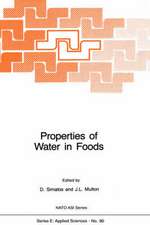Melt Rheology and its Applications in the Plastics Industry: Engineering Materials and Processes
Autor John M. Dealy, Jian Wangen Limba Engleză Paperback – 13 iun 2015
This book provides all the information that is needed for the intelligent application of rheology in the development of new polymers, the determination of molecular structure and the correlation of processability with laboratory test data. Theory and equations are limited to what is essential for the use of rheology in the characterization of polymers, the development of new plastics materials and the prediction of plastics processing behavior. The emphasis is on information that will be of direct use to practitioners. Extensive references are provided for those wishing to pursue certain issues in greater depth.
While the primary audience is applied polymer scientists and plastics engineers, the book will also be of use to postgraduate students in polymer science and engineering and as a text for a graduate course.
| Toate formatele și edițiile | Preț | Express |
|---|---|---|
| Paperback (1) | 781.31 lei 6-8 săpt. | |
| SPRINGER NETHERLANDS – 13 iun 2015 | 781.31 lei 6-8 săpt. | |
| Hardback (1) | 1112.92 lei 6-8 săpt. | |
| SPRINGER NETHERLANDS – 14 ian 2013 | 1112.92 lei 6-8 săpt. |
Din seria Engineering Materials and Processes
-
 Preț: 397.54 lei
Preț: 397.54 lei - 18%
 Preț: 1237.93 lei
Preț: 1237.93 lei - 18%
 Preț: 950.52 lei
Preț: 950.52 lei - 15%
 Preț: 646.30 lei
Preț: 646.30 lei - 18%
 Preț: 1383.00 lei
Preț: 1383.00 lei - 18%
 Preț: 1826.07 lei
Preț: 1826.07 lei - 5%
 Preț: 676.35 lei
Preț: 676.35 lei - 18%
 Preț: 1237.80 lei
Preț: 1237.80 lei - 18%
 Preț: 1228.62 lei
Preț: 1228.62 lei - 15%
 Preț: 644.95 lei
Preț: 644.95 lei - 15%
 Preț: 636.63 lei
Preț: 636.63 lei - 18%
 Preț: 1217.41 lei
Preț: 1217.41 lei - 20%
 Preț: 337.00 lei
Preț: 337.00 lei - 20%
 Preț: 557.21 lei
Preț: 557.21 lei - 15%
 Preț: 644.18 lei
Preț: 644.18 lei - 18%
 Preț: 956.50 lei
Preț: 956.50 lei - 15%
 Preț: 640.06 lei
Preț: 640.06 lei - 23%
 Preț: 691.73 lei
Preț: 691.73 lei - 18%
 Preț: 941.50 lei
Preț: 941.50 lei - 18%
 Preț: 945.30 lei
Preț: 945.30 lei - 18%
 Preț: 952.09 lei
Preț: 952.09 lei - 15%
 Preț: 635.31 lei
Preț: 635.31 lei - 18%
 Preț: 1383.81 lei
Preț: 1383.81 lei - 15%
 Preț: 644.95 lei
Preț: 644.95 lei - 18%
 Preț: 1222.45 lei
Preț: 1222.45 lei - 18%
 Preț: 1322.04 lei
Preț: 1322.04 lei - 18%
 Preț: 945.30 lei
Preț: 945.30 lei - 15%
 Preț: 640.02 lei
Preț: 640.02 lei - 18%
 Preț: 1545.72 lei
Preț: 1545.72 lei - 24%
 Preț: 848.85 lei
Preț: 848.85 lei - 18%
 Preț: 937.05 lei
Preț: 937.05 lei - 18%
 Preț: 1115.14 lei
Preț: 1115.14 lei - 15%
 Preț: 632.55 lei
Preț: 632.55 lei - 18%
 Preț: 948.79 lei
Preț: 948.79 lei
Preț: 781.31 lei
Preț vechi: 952.81 lei
-18% Nou
Puncte Express: 1172
Preț estimativ în valută:
149.54€ • 161.42$ • 125.39£
149.54€ • 161.42$ • 125.39£
Carte tipărită la comandă
Livrare economică 19 aprilie-03 mai
Preluare comenzi: 021 569.72.76
Specificații
ISBN-13: 9789401782807
ISBN-10: 9401782806
Pagini: 300
Ilustrații: XVI, 282 p.
Dimensiuni: 155 x 235 x 16 mm
Greutate: 0.42 kg
Ediția:2nd ed. 2013
Editura: SPRINGER NETHERLANDS
Colecția Springer
Seria Engineering Materials and Processes
Locul publicării:Dordrecht, Netherlands
ISBN-10: 9401782806
Pagini: 300
Ilustrații: XVI, 282 p.
Dimensiuni: 155 x 235 x 16 mm
Greutate: 0.42 kg
Ediția:2nd ed. 2013
Editura: SPRINGER NETHERLANDS
Colecția Springer
Seria Engineering Materials and Processes
Locul publicării:Dordrecht, Netherlands
Public țintă
Professional/practitionerCuprins
Preface.- 1.Introduction to Rheology: 1.1 What is rheology?.- 1.2 Why rheological properties are important.- 1.3 Stress- a measure of force.- 1.4 Strain – a measure of deformation.- 1.5 Rheological Phenomena.- 1.6 Why polymeric liquids are non-Newtonian and elastic.- 2.Viscosity and the Normal Stress Differences: 2.1 Simple shear and steady simple shear.- 2.2 Viscometric flow.- 2.3 The viscometric functions.- 2.4 The Viscosity.- 2.5 Normal stress differences.- References.- 3. Linear Viscoelasticity: 3.1 Introduction.- 3.2 Stress relaxation and the relaxation modulus.- 3.3 The Boltzmann superposition principle.- 3.4 Start-up of steady simple shear.- 3.5 Relaxation moduli of rubbers and molten polymers.- 3.6 The Maxwell model for the relaxation modulus.- 3.7 The generalized Maxwell model and the discrete relaxation spectrum.- 3.8 The continuous spectrum.- .9 Creep and creep recovery: The compliance.- 3.10 Start-up of steady simple extension.- 3.11 Small amplitude oscillatory shear.- 3.12 Inferring a discrete relaxation spectrum from storage and loss moduli.- 3.13 Combining creep and oscillatory shear data.- 3.14 Time-temperature superposition.- 3.15 Cole-Cole and related plots of linear data.- 3.16 Van Gurp-Palmen Plot of Loss Angle Versus Complex Modulus.- 3.17 Storage and loss moduli of molten linear polymers.- 3.18 Theplateau modulus and the molecular weight between entanglements.- 3.19 The Rouse-Bueche model for unentangled melts.- 3.20 Tube models for entangled melts.- 3.21 Molecular weights fo the onset of entanglement effects.- 3.22 Summary.- References.- 4. Nonlinear Viscoelasticity – Phenomena: 4.1 Introduction.- 4.2 Nonlinear phenomena from a tube modelp of view.- 4.3 Nonlinear stress relaxation.- 4.4 Dimensionless groups used to plot rheological data.- 4.5 The viscosity in terms of the tube model.- 4.6 Transient shear tests at finite rates.- 4.7 Extensional flow behavior – Introduction.- 4.8 Extensional Flow Behavior of Melts.- 4.9 Shear modification.- 4.10 Time-temperature superposition of nonlinear properties.- References.- 5. Nonlinear Viscoelasticity – Models: 5.1 Introduction.- 5.2 Tensor notation.- 5.3 The stress tensor.- 5.4 A strain tensor for infinitesimal deformations.- 5.5 The Boltzmann superposition principle in tensor form.- 5.6 Strain tensors for large, rapid deformations.- 5.7 Integral constitutive equations based on continuum mechanics.- 5.8 Continuum differential constitutive equations.- 5.9 Constitutive equations from molecular models.- 5.10 Numerical simulation of melt flows.- References.- 6. Measurement Techniques: 6.1. Introduction.- 6.2. Rotational and other drag-flow rheometers.- 6.3. Pressure-driven rheometers.- 6.4 On-line rheometers.- 6.5 High-throughput rheometry.- 6.6. Extensional rheometers.- 6.7 Torque Rheometers.- 6.8 Using Rheology for statistical process control.- 6.9 Sample Stability: Thermo-oxidative degradation and hydrolysis.- Reference.- 7. Rheology and molecular structure: 7.1 Rheology and structure of linear polymers.- 7.2 Long-chain branching and melt rheology.- References.- 8. Role of Rheology in Plastics Processing: 8.1.Introduction.- 8.2 Flow in simple channels and dies.- 8.3 Flow in an extruder.- 8.4 Sheet extrusion/film casting.- 8.5 Extrusion coating.- 8.6. Film blowing.- 8.7 Blow molding.- 8.8 Injection molding.- 8.9. Rotational molding.- 8.10. Foam Extrusion.- References.- Appendix A Structural and Rheological Parameters for Several Polymers.- Appendix B The Displacement Gradient Tensor.- Subject Index.
Textul de pe ultima copertă
This is the second edition of Melt Rheology and its Role in Plastics Processing, although the title has changed to reflect its broadened scope. Advances in the recent years in rheometer technology and polymer science have greatly enhanced the usefulness of rheology in the plastics industry. It is now possible to design polymers having specific molecular structures and to predict the flow properties of melts having those structures. In addition, rheological properties now provide more precise information about molecular structure.
This book provides all the information that is needed for the intelligent application of rheology in the development of new polymers, the determination of molecular structure and the correlation of processability with laboratory test data. Theory and equations are limited to what is essential for the use of rheology in the characterization of polymers, the development of new plastics materials and the prediction of plastics processing behavior. The emphasis is on information that will be of direct use to practitioners. Extensive references are provided for those wishing to pursue certain issues in greater depth.
While the primary audience is applied polymer scientists and plastics engineers, the book will also be of use to postgraduate students in polymer science and engineering and as a text for a graduate course.
This book provides all the information that is needed for the intelligent application of rheology in the development of new polymers, the determination of molecular structure and the correlation of processability with laboratory test data. Theory and equations are limited to what is essential for the use of rheology in the characterization of polymers, the development of new plastics materials and the prediction of plastics processing behavior. The emphasis is on information that will be of direct use to practitioners. Extensive references are provided for those wishing to pursue certain issues in greater depth.
While the primary audience is applied polymer scientists and plastics engineers, the book will also be of use to postgraduate students in polymer science and engineering and as a text for a graduate course.
Caracteristici
Completely updated version of standard work in this field Emphasis on practical applications Includes extensive references Includes supplementary material: sn.pub/extras

























